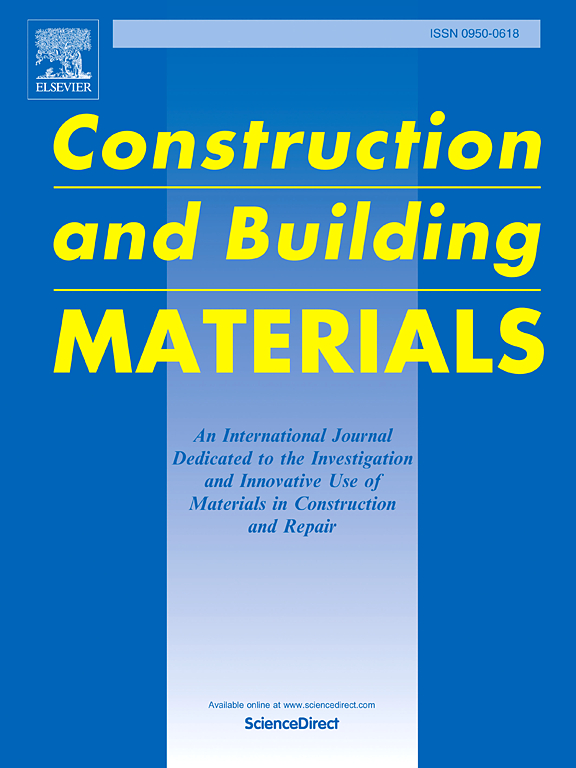橡胶混凝土冻融破坏机理试验研究及损伤演化分析评价
IF 7.4
1区 工程技术
Q1 CONSTRUCTION & BUILDING TECHNOLOGY
引用次数: 0
摘要
混凝土冻融损伤的可靠评估对于相关结构抗冻性的精确设计和风险评估至关重要,从而最大限度地发挥橡胶混凝土的抗冻性效益。本研究旨在通过实施标准化试验流程,准确、稳健地描述冻融循环作用下橡胶混凝土冻融损伤的演变过程。研究发现橡胶颗粒对混凝土抗冻性能有显著影响。其中,RC3试件在破坏点的冻融循环次数达到275次,比普通混凝土试件多100次,比充气混凝土试件多50次。此外,预处理橡胶屑进一步延缓了橡胶混凝土的破坏。当RC1-RC5被认为失败时,KRC1-KRC5的Pn值比RC1-RC5增加5.9-17.9 %,Wn最大减少2.0 %。橡胶屑的掺入对混凝土孔隙结构的改变对其抗冻性能有显著影响。本研究阐明了橡胶混凝土的冻融损伤机理,突出了橡胶混凝土基质在冻融循环作用下与常规混凝土基质在孔隙结构特征和演化模式上的差异。通过综合分析,建立了橡胶混凝土抗冻性ηm、Edtn和ψn的关系式,为评估冻融损伤和抗冻耐久性提供了一套新的可靠的评估方程。本文章由计算机程序翻译,如有差异,请以英文原文为准。
Experimental study on freeze-thaw failure mechanism of rubberized concrete and analytical evaluation of the damage evolution
A robust evaluation of freeze-thaw damage in concrete is essential for precise design and risk assessment of frost resistance in related structures, maximizing the benefits of rubberized concrete's frost resistance. This study aims to accurately and robustly describe the evolution of freeze-thaw damage in rubberized concrete subjected to freeze-thaw cycles through the implementation of standardized testing processes. The study observed a significant impact of crumb rubber on concrete frost resistance. Specifically, the number of freeze-thaw cycles that the RC3 specimens withstood reached up to 275, which is 100 and 50 cycles greater than that of normal concrete and air-entrained concrete specimens, respectively, at the point of failure. Additionally, pretreating crumb rubber further delays the damage in rubberized concrete. When RC1–RC5 were deemed failed, the value of Pn for KRC1–KRC5 increased by 5.9–17.9 % compared to that of RC1–RC5, with a maximum reduction in Wn of 2.0 %. The alterations in the pore structure of concrete due to the incorporation of crumb rubber were found to significantly influence frost resistance. This study clarifies the freeze-thaw damage mechanism of rubberized concrete, highlighting the differences in pore structure characteristics and the evolution patterns of the rubberized concrete matrix under freeze-thaw cycles compared to conventional concrete matrices. A comprehensive analysis led to the development of equations for ηm, Edtn, and ψn related to the frost resistance of rubberized concrete, presenting a new set of robust evaluation equations for assessing freeze-thaw damage and frost resistance durability life.
求助全文
通过发布文献求助,成功后即可免费获取论文全文。
去求助
来源期刊

Construction and Building Materials
工程技术-材料科学:综合
CiteScore
13.80
自引率
21.60%
发文量
3632
审稿时长
82 days
期刊介绍:
Construction and Building Materials offers an international platform for sharing innovative and original research and development in the realm of construction and building materials, along with their practical applications in new projects and repair practices. The journal publishes a diverse array of pioneering research and application papers, detailing laboratory investigations and, to a limited extent, numerical analyses or reports on full-scale projects. Multi-part papers are discouraged.
Additionally, Construction and Building Materials features comprehensive case studies and insightful review articles that contribute to new insights in the field. Our focus is on papers related to construction materials, excluding those on structural engineering, geotechnics, and unbound highway layers. Covered materials and technologies encompass cement, concrete reinforcement, bricks and mortars, additives, corrosion technology, ceramics, timber, steel, polymers, glass fibers, recycled materials, bamboo, rammed earth, non-conventional building materials, bituminous materials, and applications in railway materials.
 求助内容:
求助内容: 应助结果提醒方式:
应助结果提醒方式:


